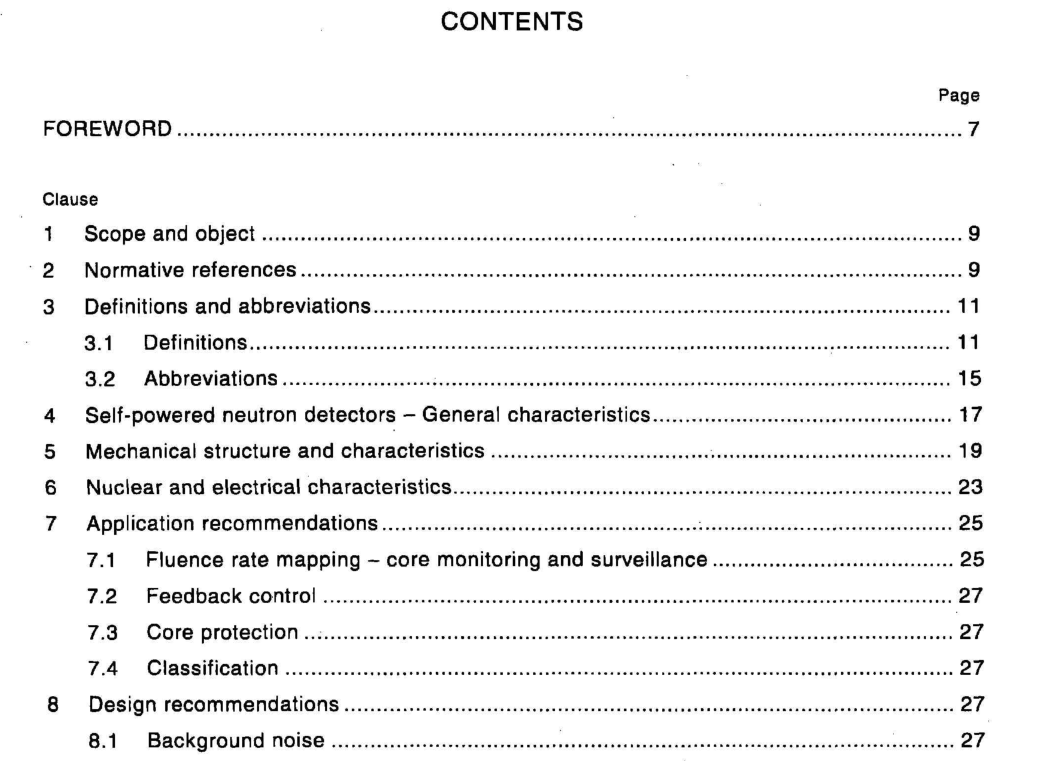IEC 61468 pdf download

IEC 61468 pdf download.Nuclear power plants – In-core instrumentation – Characteristics and test methods of self-powered neutron detectors
1 Scope and object
This International Standard applies to in-core neutron detectors and instrumentation which are designed for purposes important to safety: protection, control and information. It is restricted to characteristics and test methods for self-powered neutron detectors (SPNDs). Self-powered neutron detectors can be used for neutron fluence rate (flux) measurements and spatial power measurements in nuclear reactors. This standard gives requirements, recommendations and guidance on selection of the type and characteristics of SPNDS for different possible applications of SPNDs. For the principles of overall plant and I&C system design and the purpose of neutron fluence rate measurements, reference should be made to general principles of nuclear reactor instrumentation according to IAEA Codes and Safety Guides and IEC 61513.
3 Definitions and abbreviations
3.1 Definitions For the purpose of this publication, the following definitions apply: 3.1.1 background or lead-compensation (of a self-powered detector signal) a method employed to correct the current from a SPND for background contribution. This is usually accomplished by placing an “emitterless” background detector in the in-core assembly, or by using detectors with an internal compensating lead wire (see figure 3) 3.1.2 beta decay radioactive decay process in which mass number A remains unchanged but the atomic number changes. Processes include electron emission (β- decay), electron capture, and positron emission (β+ decay) 3.1.3 burn-up depletion or reduction of target atoms when exposed to a thermal neutron fluence rate over time, due to conversion to other radioisotopes 3.1.4 burn-up life (of a neutron detector) estimated fluence of neutrons of a given energy distribution after which the sensitive material will. be consumed to such an extent that the detector characteristics exceed the specified tolerances for a specified purpose [IEV 394-18-30] 3.1.5 capture cross-section measure of the probability of a particular collision or interaction process, stated as the effective area which target particles present to incident particles for that process
SPNDs may be located in the reactor core as single elements, or more typically, in assemblies of several units grouped around a central tube in which the sensor of a calibration system can be located. Examples are described in A.5, showing typical assembly configurations used in light water and heavy water nuclear power plants. SPNDS are available in a variety of designs with sensitive lengths ranging from a few centimetres to full core height. The design of an SPND should incorporate proper selection of emitter type and thickness, as well as sheath and insulation material types and dimensions, to optimize the mechanical design for a specific radiation measurement. The material of the collector and lead cable sections shall be resistant to corrosion effects if in contact with the primary coolant under normal operation and transient conditions. SPNDs may be installed in assemblies in which the SPND elements are not in contact with the primary coolant, to eliminate the effects of corrosion and extend the element lifetime. The collector may be fabricated from nickel-based alloys, characterized by low manganese content and excellent corrosion resistance. (Low manganese content of less than 1 % is desired because manganese produces interfering beta emissions when exposed to neutrons.) The insulation should be virtually transparent to neutrons or gamma fluence rate, i.e. it should have an extremely low probabilty of interaction with neutrons or gamma rays. It should ensure that the detector maintains a resistance between centre conductor and collector in excess of 107 Q in “hot” operating conditions, and in excess of 1012 Q for “cold” nonoperating conditions. Ceramic oxides are the preferred materials because they can withstand the hostile environment inside a nuclear reactor. . Typically, three materials may be used for the insulation in SPNDs employed in power reactor applications, namely, Al2Og, MgO and SiO2. Al2O3 has been chosen for most applications as it is readily available and, in powder form, is less sensitive than MgO to the effects of humidity. MgO is hygroscopic and is therefore sensitive to cable swelling if moisture penetrates the cable sheath. SiO2 may be used in some applications because its low density enhances emitter to collector electron transmission and thus maximizes sensitivity characteristics. However SiO2 has lower insulation resistance at high temperature than MgO or Al2Og.









